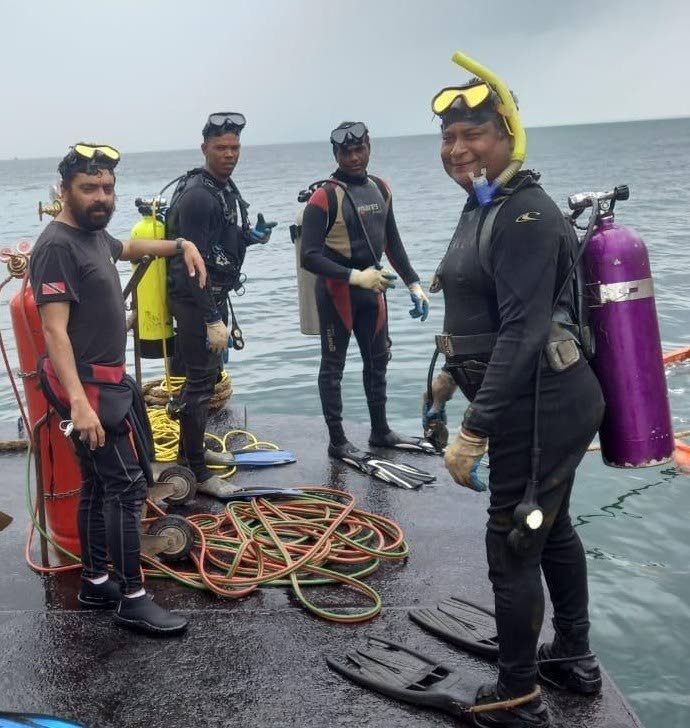Institute's recommendation to Paria – Underwater pipelines must be mapped

THE Institute of Surveyors of Trinidad and Tobago (ISTT) is recommending that Paria Fuel Trading Company Limited map an updated cadastre of its pipelines in the Gulf of Paria.
In a written submission to the Commission of Enquiry into the Paria diving tragedy, which cost four men their lives in February 2022, the ISTT said the pipeline where the deadly accident happened, was constructed between 50 to 70 years ago.
On March 25, 2022, while conducting repairs in an undersea oil pipeline at Paria Fuel Trading Company Ltd, Pointe-a-Pierre, divers Fyzal Kurban, Kazim Ali Jr, Rishi Nagassar, Yusuf Henry and Christopher Boodram were sucked into the pipeline by a vortex created by a sharp difference in water pressure known as a Delta P. Only Boodram survived.
Following outcry over the deaths and the responses by the entities involved, the Commission of Enquiry was convened with King's Counsel Jerome Lynch as chairman and Gregory Wilson as co-commissioner. The formation of the commission was announced on April 22, 2022 and began sitting in November 2022, with evidence concluding in March 2023.
"The topography of the seabed was, at best, uncertain given the propensity for soft mud to have accumulated over the decades, from the discharge of Venezuelan rivers into the Gulf of Paria, rendering the pipelines and the seabed of the Gulf of Paria almost opaque to contemporary surveying equipment and measurements," the ISTT said.
The Institute said Paria has a significant knowledge gap to close, as the historical data and maps of the original pipelines may have been misplaced or lost over the years.
The ISTT said it would be difficult to manage and maintain the pipelines without knowledge of the exact location, depths and other details of the infrastructure.
"As such the mapping and preparation of an accurate marine cadastre for the Gulf of Paria is strongly recommended to prevent future disasters. The Hydrographic Unit of the Surveys and Mapping Division can assist with basic mapping," the ISTT said.
The group, which describes itself as the professional body of surveyors in T&T, said the levels of fluids in the vertical pipeline should have been measured "relative to a common benchmark, given the approximate 400-metre distance between the risers."
The group said this would have indicated a better relative distance for the ullage in the pipeline to be achieved.
The ISTT's letter was published on the Commission's website, with a note stating it was received on April 17 and inviting responses.
On April 23, attorney Gretel Baird who represents Paria responded dismissing the ISTT's opinion.Baird said ISTT was not a party of the Commission and had no standing.
He said the Institute's comments come after the evidential hearings had concluded and Paria's legal team did not have an opportunity to challenge any of the opinions presented.
Baird questioned why the ISTT delayed in submitting its letter to the Commission, saying "such delay is clearly inexcusable."
"Allowing ISTT's to provide expert evidence by way of letter would be manifestly unfair and highly prejudicial in those circumstances," he said.
Baird said the ISTT's letter also did not name the surveyors who gave their opinion in the letter. He said there was no scientific underpinning for the opinions in the letter.
Labelling the submission as "highly speculative", Baird called for it to be disregarded.
In her response to the Institute's letter attorney for LMCS, Kamini Persaud-Maraj said the company largely agreed with the ISTT.
"LMCS Limited during the Commission had indeed raised the issue of the pipeline profile between Berths 5 and 6. The record will show that it was accepted by several of Paria’s witnesses that there were no drawings or pipeline profile between Berths 5 and 6 at SL (sealine) 36. As such LMCS concurs with points 1-3 of the statement," Persaud-Maraj said.
She said the evidence given by the accident's lone survivor, Christopher Boodram, also pointed to the pipeline not being flat.
However, she said LMCS did not agree with the Institute's definition of the measuring of the ullage.
"Ullage, I am instructed, is taken from the top of the pipeline at mean sea level. Again, the evidence from LMCS was that the ullage was taken at the riser at Berth No. 6," Persaud-Maraj said.


Comments
"Institute’s recommendation to Paria – Underwater pipelines must be mapped"